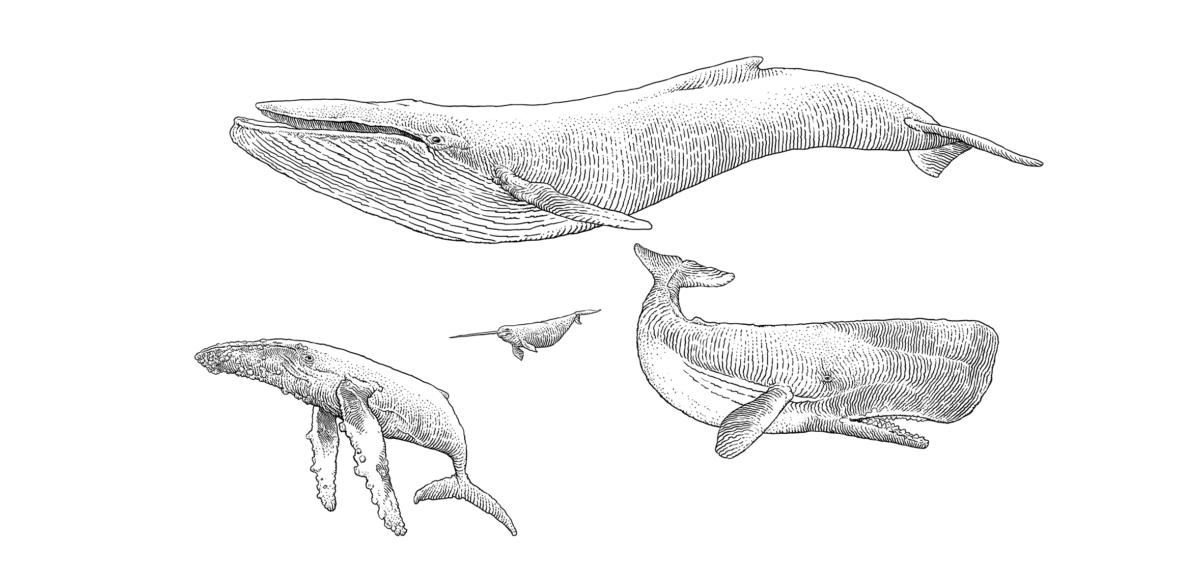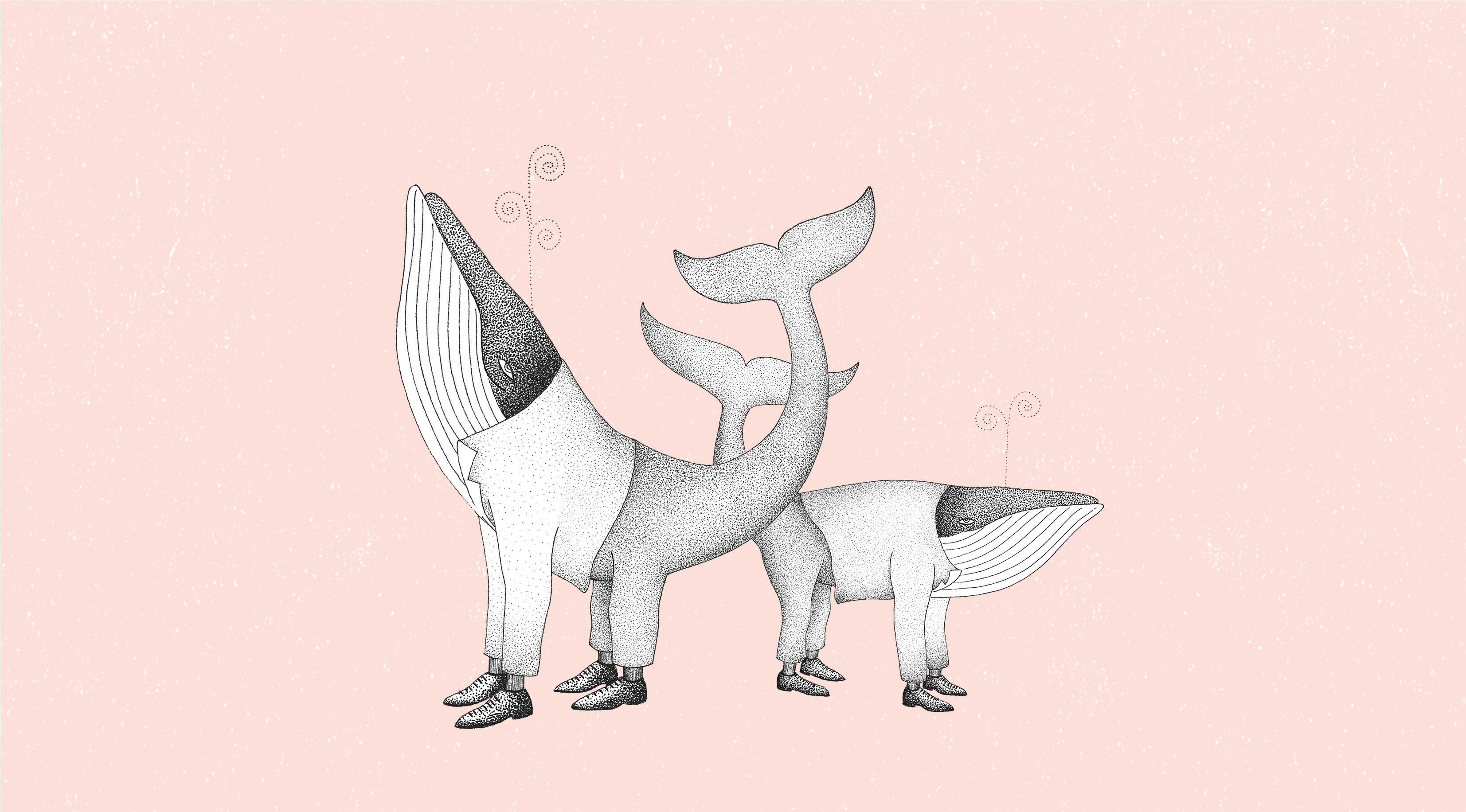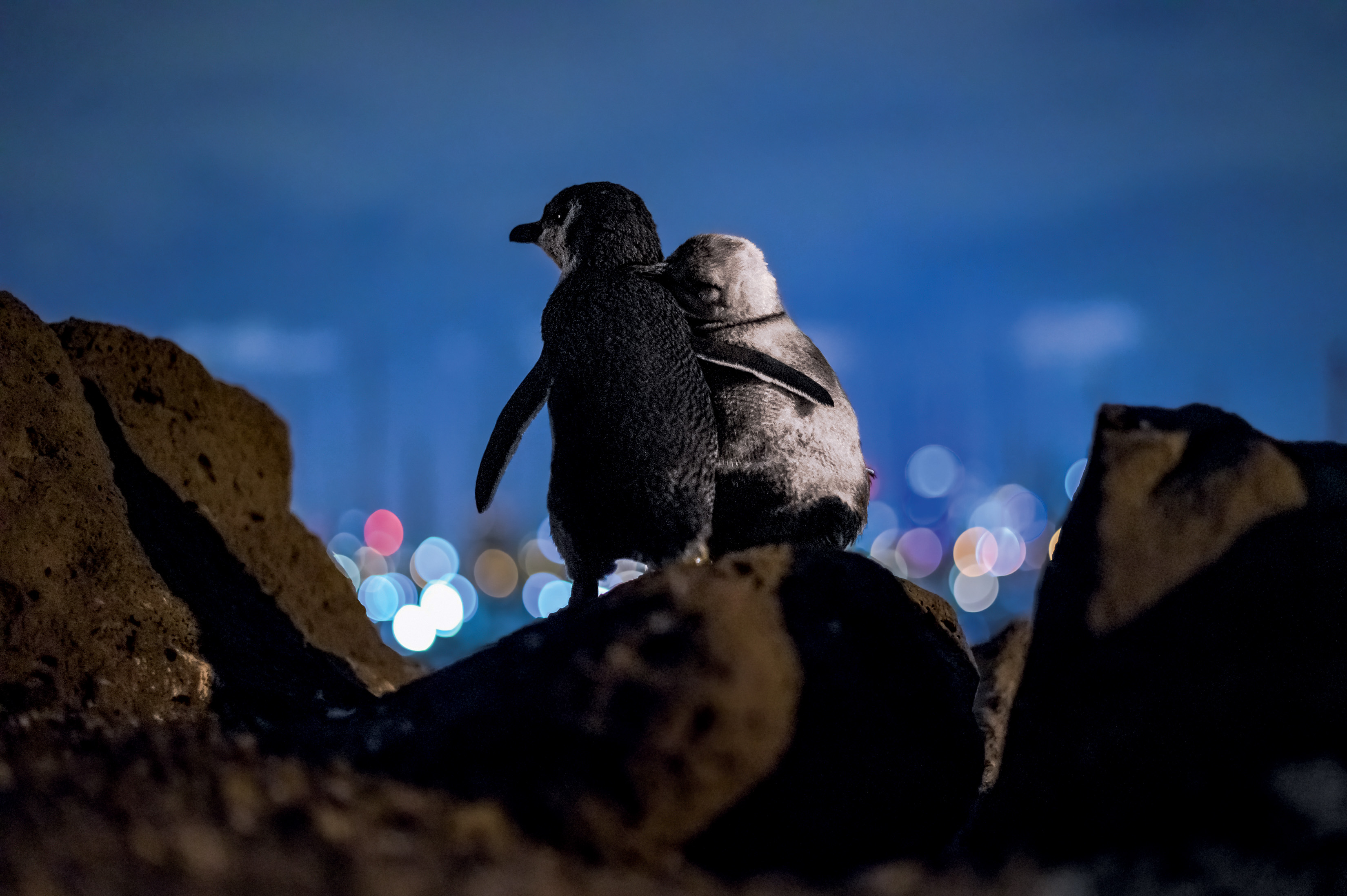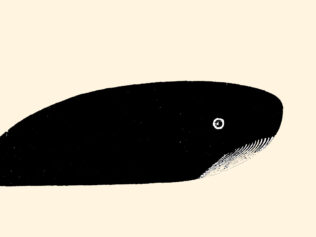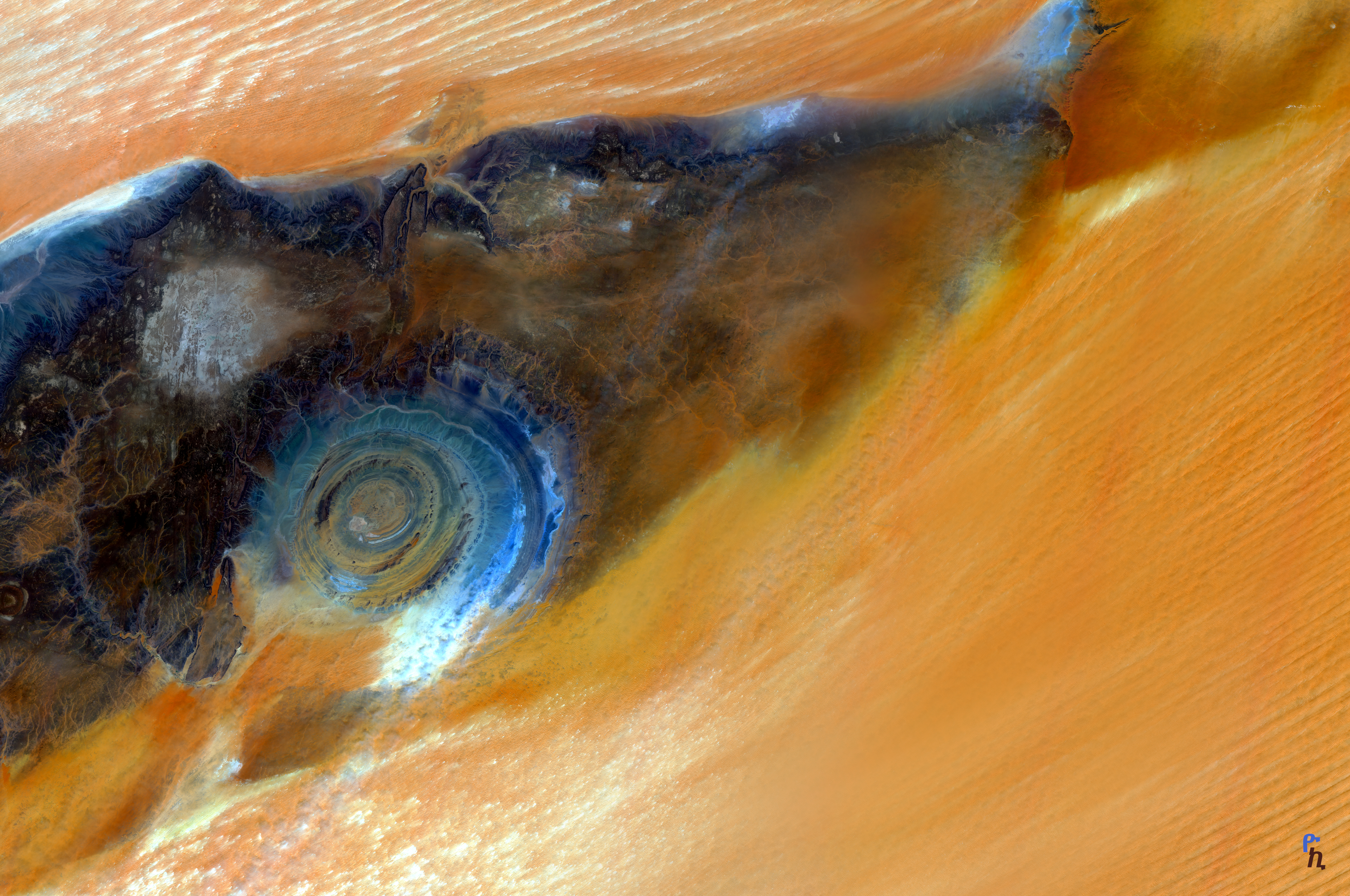
The Lonely Singer
Oceans are vast spaces in which even a huge whale is a small, lonely dot. But in the course of evolution, these dots have developed a system of communication which allows them to find each other.
For example, the vocalizations of the blue whale—the largest of them all—travels thousands of miles through the depths of the ocean, reaching an impressive volume of 188 decibels. Sperm whales are even louder—up to 230 dB. For comparison, a jet engine is only 140 dB—as loud as a gunshot. Humans would find it difficult to hear these sounds, as most of them are much too low for their ears.
Every whale species uses a different frequency in the 10-40 hertz range. But there is one individual among them which broadcasts outside of that range, officially considered to be the loneliest cetacean in the world—the “52-hertz whale,” famous for its romantic, tragic nature. Otherwise known as 52 Blue, scientists found out about its existence in 1989, when hydrophones recorded a song that was clearly that of a gentle giant, but with a completely different character than the sounds made by the rest of the known species. Nobody else calls at 52 Hz. Ever since then the whale (about which nothing else is known—neither its sex, species, nor why it sings so strangely) has been swimming in solitude around the Pacific, wistfully calling for a mate in a language nobody else can understand, or perhaps even hear.
The White Giant
The most famous sperm whale is undoubtedly Moby Dick, the gigantic cachalot immortalized by Herman Melville. The author was inspired by his own experiences, but first and foremost the story of the whaling ship Essex, which, in 1819, was battered and sunk by a huge male of the same species. It is also true that sperm whales get lighter in color as they age, scar, and molt. These cetaceans are generally docile, but they are capable of defending themselves and their families. While at present they reach around sixty-five feet in length, research indicates that two hundred years ago they may have been much bigger, perhaps even a hundred feet long. Only intense persecution by humans, who picked out the largest individuals, caused the species to shrink.
This means that a whale resembling Moby Dick could have really existed in the past. And certainly there is a snow-white humpback named Migaloo living off the coast of Australia. This albino male was first spotted in 1991 and has been one of the continent’s popular attractions ever since. Its name comes from some Indigenous languages of Queensland, and means “white fella.”
Runaway Humpbacks
Whales know no boundaries and most species can be found in the oceans of both hemispheres. Very similar species—which in the recent evolutionary past were the same—can now live in different oceans. It appears, however, that even members of the same, cosmopolitan group are surprisingly conservative when choosing their travel routes.
The typical pattern for migrating whales is that they spend the summer months gorging themselves in the food-rich polar regions, and when winter comes, they travel to the tropics to find partners and have offspring. This is what it looks like in the case of humpback whales, whose yearly migrations reach a distance of almost 12,000 miles and are the longest of all mammals.
Those living in the southern hemisphere spend the local summer in the Antarctic and when winter arrives in May, they move towards the equator. A short while earlier their northern kin would have left this region—for them the summer is coming, so it’s time to leave for the Arctic.
Even though they are the same whales and they share breeding grounds, they will never encounter each other there. This is why some scientists claim they should be considered separate subspecies.

There She Blows!
Whales usually appear as a dark shape under the water’s surface, which from time to time exhales, creating something known as a spout, or a blow. Whales breathe rarely, but very quickly—in order to limit the time spent above the surface—and their nostrils are, very sensibly, placed on the top of their skull.
Unlike for humans, it is a conscious action, which is why it’s impossible to place them under general anesthesia: without controlling their breathing, they can drown. Their breathing is also very effective—every time they replace about 80-90 percent of the air in their lungs, compared to the paltry 10-15 percent that humans do.
The exhale of a surfacing cetacean is so violent that it resembles a sneeze. This is why its contents usually comprise compressed air, a bit of water vapor, a few drops of water that were just on the whale’s nose, and a lot of snot.
The shape of this mucus cloud depends on the shape of the nostrils, or blowhole, which can often be used to identify species. The wind and the waves also influence how this appetizing mist appears, but generally one can assume that if it’s rather round and fuzzy, the culprit is a long-finned pilot or humpback whale. If it’s angled forward and sideways, we have almost certainly encountered a sperm whale. If it’s a tall, narrow column, a blue whale, fin whale, or sei whale (their nostrils differ in size) is swimming ahead. If the blow is heart-shaped, with two distinct streams diverging at an angle, one of the Balaenidae family is responsible: a North Atlantic right whale, bowhead whale, or southern right whale.
Here’s to many happy encounters with whale breath, just don’t get too close because you’ll need to clean your clothes after.
Whale Fur
Initially, humans hunted whales for their meat, but the 17th century saw a gradual rise in demand for their blubber—used for making candles, grease, and lamp oil—and baleen, a keratinous substance and raw material for a huge range of items, from buttons to combs and corsets. It wasn’t until the 20th century that it began to be replaced by plastic.
When whale numbers started rapidly declining in the first half of the 20th century, regulations were introduced mandating the use of whole bodies of captured cetaceans. Their blubber was no longer used only for making candles, but also margarine, shoe polish, and was even used as an ingredient for nitroglycerin. The bones and meat were ground into meal, which could become fertilizer or feedstuff. Of particular importance was spermaceti, an extremely pure oil found in the skulls of sperm whales, which even lubricated some parts of the first spaceships.
Thankfully, today hardly anyone hunts large whales, apart from certain Indigenous communities and a handful of countries: Norway, Iceland, Japan. Most of the whale meat acquired on an industrial scale is not currently consumed by humans—as predators at the top of the food chain, whales accumulate vast amounts of environmental pollutants in their tissue—but by farmed minks, which provides another argument against wearing fur.
Deep Dive
Although, like humans, whales breathe air, they can dive to great depths and stay underwater for a long time. Among many other anatomical and physiological adaptations, this is made possible by a high content of myoglobin in their tissues. This hemoglobin-like compound binds oxygen and can be found in the muscles of all mammals, but whales have thirty percent more than their land-based relatives. Their blood contains twice as much hemoglobin as that of humans, which means oxygen gets transported to tissues faster. This allows whales to draw the life-sustaining element from their muscles, rather than their lungs, while diving.
Until recently, the sperm whale was considered to hold the record for diving depth at 1.2 miles. That’s deeper than the largest seal—the southern elephant seal—which, in turn, held the mammalian record for length of time underwater at two hours. However, all that changed in 2014, when scientists discovered that both these unsurpassed statistics could in fact be beaten by a cetacean with the mysterious name of ziphius, also called Cuvier’s beaked whale. About twenty-three feet long and belonging to the least-known family of Ziphiidae, they can submerge to a depth of up to 1.8 miles and remain underwater for 137 minutes. As far as we know, no other mammal can do that.
The Oldest Mammal
It is difficult to assess the lifespan of whales, but it is generally assumed that it is comparable to that of humans. However, a bowhead whale was caught in May 2007 off the coast of Alaska which had the blade of a bomb lance embedded in its body. The lance was used to try and kill the animal around the year 1880. Since whale calves were not hunted at that time, the unfortunate whale must have been at least 150 years old when it died—another record among mammals.


